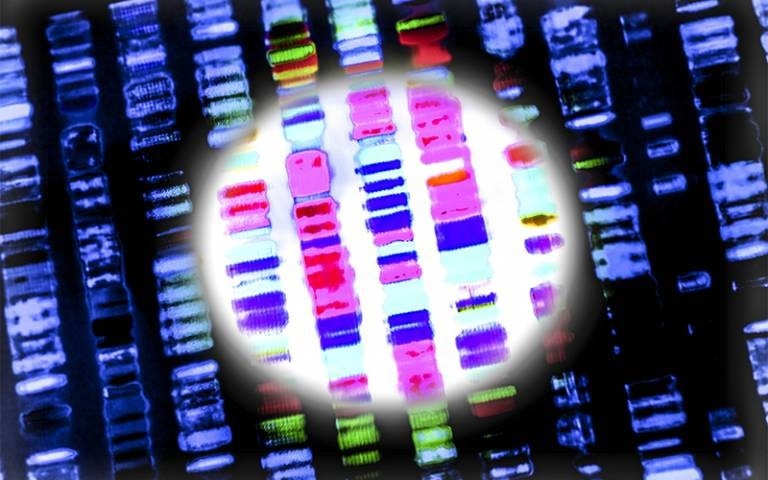The NHS Genomic Medicine Service, launched by the Department of Health in the United Kingdom in 2018, enables patients with unusual conditions to have their complete genetic code evaluated in the hopes of gaining a critical diagnosis.
 Graphic representation of the DNA sequence. Image Credit: Gio_tto on iStock
Graphic representation of the DNA sequence. Image Credit: Gio_tto on iStock
However, deciphering this data can be extremely challenging, and there are still many patients with complex, rare genetic illnesses who are struggling without a biological explanation.
Investigators from The London Mitochondrial Centre at UCL Queen Square Institute of Neurology and UCL Great Ormond Street Institute of Child Health attempted to enhance such children’s chances of receiving a genetic diagnosis in the study, which was published in Nature Communications.
To do this, they investigated if utilizing a genomic medicine team of specialized physicians, bioinformaticians, and scientists could enhance the NHS diagnostic laboratories' capabilities beyond the usual semi-automated data analysis.
To find hints that could assist guide additional, more individualized studies, the UCL team reevaluated undiagnosed cases. They then employed further bioinformatic methods, utilizing cutting-edge computer technologies to locate genetic changes in patients’ DNA that may be contributing to their condition but had escaped notice during standard testing.
All patients who took part had previously undergone whole genome sequencing as part of Genomics England’s “100,000 Genomes Project” (an essential forerunner to the new NHS Genomic Medicine Service) in order to identify a genetic etiology for their suspected primary mitochondrial ailment (PMD).
PMD is a genetically varied collection of serious genetic illnesses that affect children and adults and are associated with a wide range of medical issues, severe impairments, and shortened lifespan. The customized strategy used in the study nearly quadrupled the percentage of patients receiving a diagnosis, from 16.7% to 31.4%. It also identified probable disease-causing variations in 3.9% of patients, indicating areas for future research.
The NHS has invested heavily in advanced genetic technologies. Consequently, the UK has established itself at the forefront of diagnostic whole genome sequencing. That said, some people with rare genetic diseases remain without a molecular diagnosis after their genome is analyzed. We believe investing in specialist genomic medicine teams is crucial, ensuring equitable access to dedicated multidisciplinary expertise and maximizing diagnoses.”
Dr Robert Pitceathly, Study Lead Author, Queen Square Institute of Neurology, University College London
Dr Robert Pitceathly also the co-lead for the London NHS Highly Specialised Service for Rare Mitochondrial Disorders adds, “On average, patients in our study waited over 30 years for a diagnosis—we now have the capability to solve such cases but need adequate workforce planning to support NHS diagnostic genetic laboratories in achieving this goal.”
It is crucial for patients to acquire a genetic diagnosis since it gives them access to family planning, specialized IVF, and medication trials. Additionally, it may enable access to drug studies and tailored screening for known disease consequences.
“In this study, every new genetic diagnosis had a direct impact on patient care. This included additional check-ups for heart problems, hearing loss, and diabetes, and access to clinical trials,” stated Dr Robert Pitceathly.
This work is a significant step forward in developing the best ways to maximize the benefits of genome analysis for patients. It clearly demonstrates that by combining automated approaches to genome analysis with data interpretation by a skilled multidisciplinary team the diagnostic rates doubles. This is an important finding that will influence how genomic medicine diagnostic services should evolve world-wide.”
Michael Hanna, Director and Professor, Queen Square Institute of Neurology, University College London
“The journey to reaching a diagnosis for children and adults with rare, complex, medical conditions can be a very long process, and genomic medicine provides a transformative and powerful tool in helping reach that goal,” added Co-author, Dr James Davison (Metabolic Medicine Department at Great Ormond Street Hospital and chair of the British Inherited Metabolic Diseases Group).
Dr James Davison explains, “This study highlights the importance of the collaboration between specialist clinicians and genetic scientists in interpreting the results of genome sequencing to maximize the opportunity of reaching a diagnosis which can then help guide medical management and treatment options.”
The research was financially supported by the Medical Research Council.
Patient story
Rachel North, one of the trial participants, characterized receiving a diagnosis as "life changing." It has now enabled her to be examined for disease consequences including osteopenia, which have since been addressed.
Rachel North elaborates, “I had attended so many hospitals over the past 20 years and had been searching so long, I never thought I’d get a diagnosis. Wondering about it took up so much energy, and I was worried about my 12-year-old son, and if my condition would affect him. So, getting a rare recessive diagnosis was a relief and takes away fear of the unknown.”
“Having a diagnosis allows me to research my condition and be very proactive in managing it. Anything that helps me understand and make sense of what is happening to my body helps me come to terms with it and gives me confidence that I am managing it as well as possible,” concluded Rachel North.
Source:
Journal reference:
Macken, W. L., et al. (2022) Specialist multidisciplinary input maximizes rare disease diagnoses from whole genome sequencing. Nature Communications. doi.org/10.1038/s41467-022-32908-7.